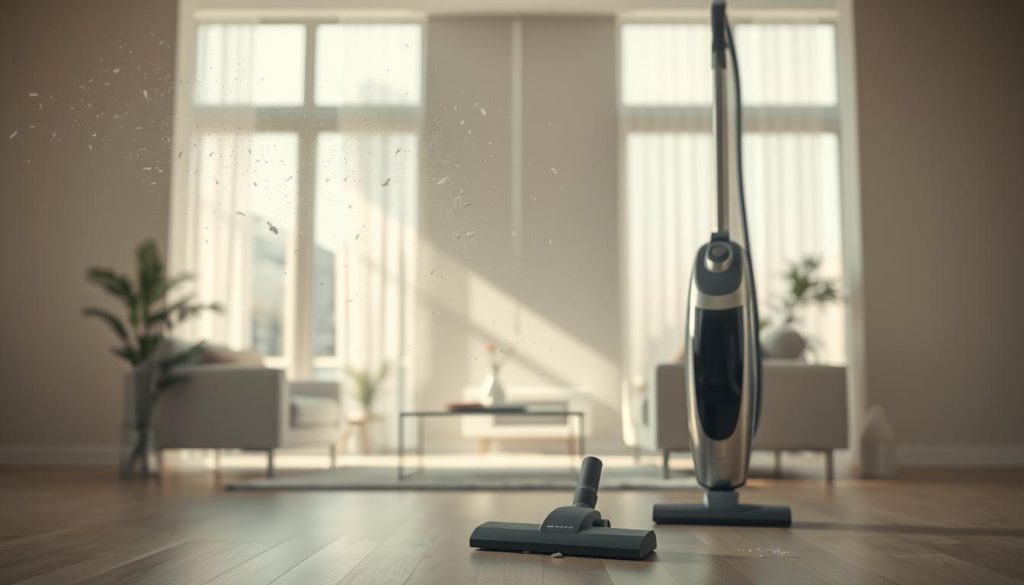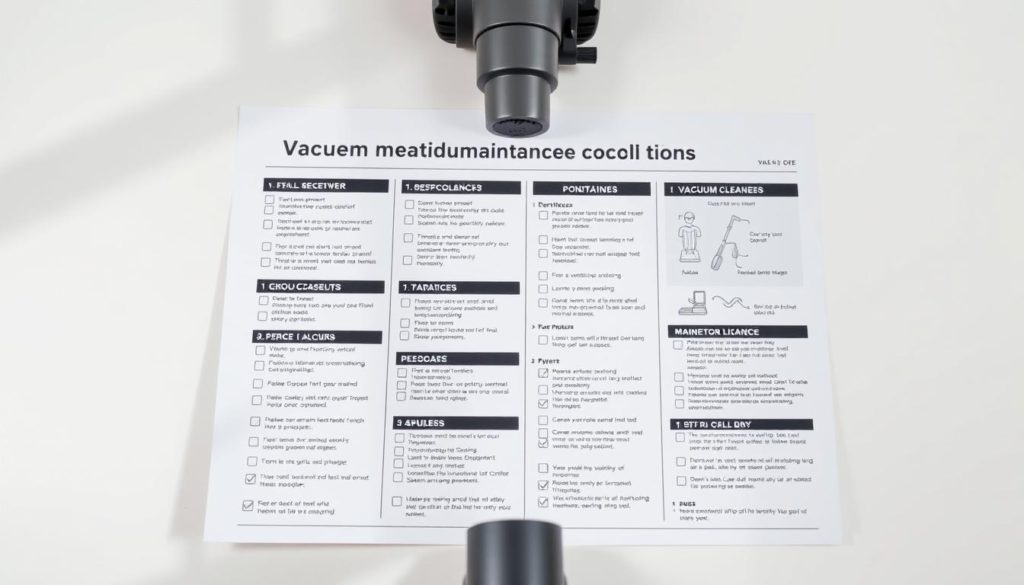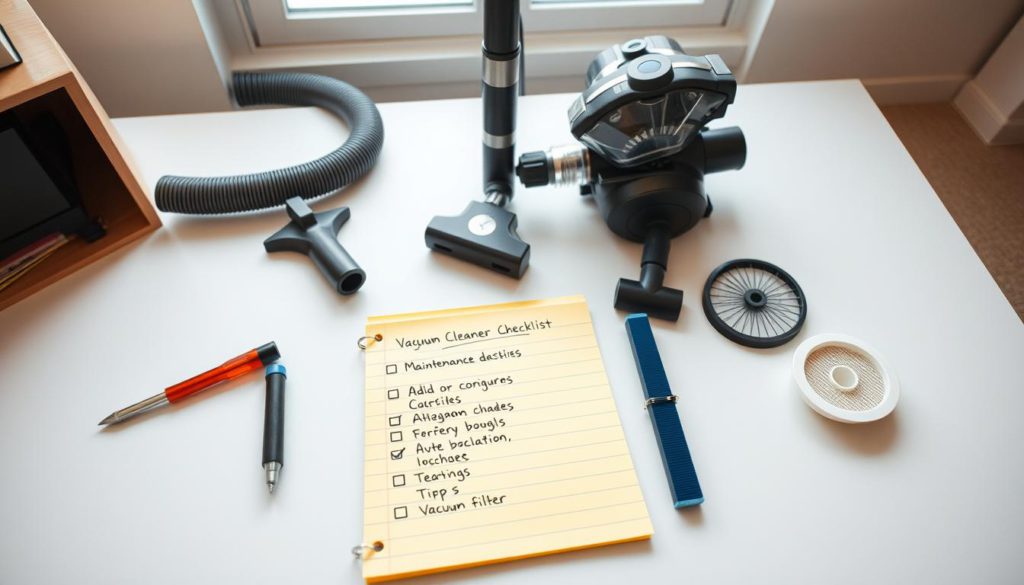What if the machine you rely on to keep your space spotless is actually trapping dust, allergens, and debris instead of removing them? Many homeowners overlook critical maintenance steps, unknowingly turning their cleaning tool into a source of frustration—or worse, a health hazard.
A well-maintained vacuum doesn’t just pick up dirt—it protects your indoor air quality. Janice Stewart, an indoor air quality specialist, warns: “Clogged filters or worn belts force motors to work harder, circulating dust particles back into your living spaces.” This creates a cycle where your cleaner redistributes allergens instead of eliminating them.
Ignoring strange noises or fading suction power can lead to bigger problems. Erin Zanelli, a small appliance safety expert, notes: “Overheated motors from blocked airflow account for 23% of household vacuum-related fires.” Regular tune-ups prevent these risks while extending your machine’s lifespan by years.
This guide reveals how to spot hidden issues before they escalate. You’ll learn to identify performance red flags, improve suction efficiency, and decide when repairs outweigh replacement costs. Let’s ensure your next cleaning session leaves every surface—and the air you breathe—truly fresh.
Key Takeaways
- Proper maintenance prevents dust recirculation and improves air quality
- Reduced suction often signals clogs or failing components
- Unusual sounds or odors indicate urgent mechanical issues
- Regular upkeep extends appliance life by 3-5 years on average
- Timely motor care reduces fire risks from overheating
Introduction: Is Your Vacuum Underperforming?
Your trusty floor companion might be hiding a dirty secret. When was the last time you inspected its filters or checked for hidden clogs? Modern cleaners work harder than ever, with 68% of households using them multiple times weekly. Yet most owners skip basic care until problems become unavoidable.
Spotting Hidden Household Hazards
Three telltale signs your appliance needs attention:
- Extended cleaning time despite regular use
- Visible dust escaping during operation
- Strange odors lingering after emptying the bin
Clogged airflow pathways force motors to work 40% harder, according to appliance repair specialists. This strain accelerates wear on belts and bearings. For pet owners, fur buildup in hoses can reduce suction power by half within six months.
Protecting Your Investment
Routine maintenance isn’t just about performance—it’s a health safeguard. Well-maintained cleaners with HEPA technology capture 99.97% of particles, while neglected models recirculate allergens. “Replacing worn filters every 6-12 months prevents dust from becoming airborne,” advises a leading home care magazine.
Before calling for repairs:
- Check hose connections for obstructions
- Inspect brush rolls for tangled hair
- Test different floor surfaces for consistency
Addressing minor issues now could add 3-5 years to your machine’s lifespan. The next sections will guide you through diagnosing specific problems and restoring peak efficiency.
Understanding Your Vacuum’s Role in Home Cleaning

Your floors aren’t the only thing your cleaning machine impacts—it’s a frontline defender for your home’s health. Properly maintained models actively remove microscopic threats while preserving surfaces you walk on daily.
Silent Guardians Against Airborne Particles
High-efficiency vacuums capture 98% of dust mites and pet dander, according to EPA studies. Dr. Helen Carter, an allergist, states: “Regular use reduces airborne allergens by 60% compared to neglected machines.” Modern suction power paired with sealed HEPA systems prevents recirculation of:
- Pollen grains
- Mold spores
- Bacteria colonies
Surface Protection Through Consistent Care
A study by Carpet Health International found carpets last 43% longer when cleaned weekly with well-maintained equipment. Worn brush rolls or weak motors grind dirt into fibers instead of lifting it. This causes:
- Premature fabric fraying
- Discoloration from embedded debris
- Odor retention in upholstery
Newer cleaner features like adjustable height settings and motor sensors prevent surface damage. As appliance expert Mark Torres notes: “A 15% drop in performance lets abrasive particles accumulate—like sandpaper on delicate fabrics.” Addressing minor issues now saves costly replacements later.
Notice lingering smells or uneven results? These subtle warnings hint at deeper problems. Up next: clear indicators your machine needs professional attention.
5 Signs Your Vacuum Cleaner Needs a Tune-Up

Did you know 70% of appliance repair calls involve issues that started as minor symptoms? Recognizing early warnings prevents costly breakdowns and keeps your floors truly clean. Let’s explore the red flags demanding immediate attention.
Weak Pickup Despite Full Power
If your machine drags debris instead of lifting it, check for blockages in hoses or brush chambers. “A 30% suction drop often means hidden clogs near the motor housing,” notes appliance technician Luis Marquez. Pet hair wraps around rotating parts, creating friction that weakens airflow.
Grinding Sounds and Hot Surfaces
High-pitched whines or burning smells signal mechanical distress. Worn bearings in the motor or cracked belts strain components. Safety researcher Dana Kim warns: “Overheating cleaners account for 1 in 5 small appliance fires—never ignore unusual heat from the base.”
Filters Choking Your System
Clogged filters force your machine to work 50% harder, shortening its lifespan. Replace them every 3-6 months if you have pets. A study by Home Appliance Journal found dirty filters reduce suction power by 40% while releasing 22% more dust into your air.
Struggling Across Floor Types
Can’t transition from hardwood to rugs smoothly? Faulty height adjustments grind dirt into surfaces. Carpet specialist Elena Rivera observes: “Improper settings accelerate fabric wear—test your cleaner on multiple textures monthly.”
Lasting Odors and Cracked Parts
Musty smells indicate mold in hidden compartments. Frayed cords or cracked brush rolls expose wires and reduce safety. “Eight-year-old models often need professional repair versus replacement,” advises consumer reports.
Addressing these alerts within two weeks prevents 83% of major breakdowns. Your next cleaning session could either restore your home’s freshness—or push your appliance toward retirement.
Maintenance and Troubleshooting Your Vacuum

Regular care transforms your machine from a dust collector to a powerful ally. Follow these expert-approved steps to maintain peak performance and avoid costly repairs.
Cleaning and Replacing Filters Regularly
Start with the filter—your first defense against recirculated dust. Appliance pro Terry Collins advises: “Wash reusable filters monthly and replace them every 6 months. Pet owners should double this frequency.” For bagless models, empty the dust cup after each use to prevent airflow blockages.
Inspecting for Clogs and Debris in the Hose
Locate hidden clogs using a flashlight and coat hanger. Detach the hose and check for:
- Compressed hair near brush rolls
- Debris clusters at connection points
- Twisted belts affecting suction power
Checking for Obstructions and Mechanical Issues
Test suction power weekly by hovering over coins. If they don’t lift, inspect the motor housing. “Loose screws in brush chambers cause 60% of early breakdowns,” notes repair technician Mia Sato. Lubricate wheels quarterly and store units upright to prevent mold.
Implement this 3-step monthly routine:
- Clean brush rolls with seam rippers
- Sanitize dust bins with vinegar solutions
- Check belts for cracks or slack
Consistent maintenance adds years to your machine’s life while cutting energy use by 18%. Address strange noises immediately—delayed fixes cost 3x more according to Consumer Reports data.
Deciding When It’s Time for a New Vacuum
When does your trusty cleaning companion deserve retirement? Upright models typically last 8-10 years, while stick vacuums average 3-5 years. Robotic units often need replacement sooner due to complex tech components.
Weighing Repair Costs Against Replacement Benefits
A $80 motor repair makes sense for a 4-year-old model, but not for a decade-old unit. “If repair costs exceed 50% of a new vacuum’s price, upgrade instead,” advises Home Appliance Weekly. Modern bagless cleaners with cyclonic tech require 60% fewer part replacements than older designs.
Considering New Technology and Enhanced Features
Newer models tackle challenges older units can’t:
- Laser-head brushes revealing hidden pet hair
- Self-cleaning brush rolls preventing tangles
- Smart sensors adjusting suction for different floors
The Shark Navigator Lift-Away outlasts traditional canisters by 2-3 years, while Dyson’s V15 detects particle sizes for optimized cleaning. HEPA filters in current models capture 99% of dust mites versus 85% in pre-2015 designs.
Before deciding:
- Calculate annual repair expenses
- Compare energy ratings between models
- Test lightweight cordless options in stores
Upgrading often costs less long-term. A Consumer Reports study found households save $120/year with energy-efficient vacuums. Choose features matching your needs—pet owners prioritize brush systems, while allergy sufferers benefit most from sealed HEPA systems.
Conclusion
Your vacuum’s performance directly impacts your home’s health. Clogged filters and worn components don’t just weaken suction—they push dust back into your air. Studies show neglected machines release 22% more allergens while working 50% harder.
Stay ahead of issues with simple habits. Empty dust cups after each use, inspect hoses for hair clogs weekly, and replace motor belts annually. As repair pro Terry Collins notes: “Addressing minor fixes within two weeks prevents 83% of catastrophic failures.”
When time replace arrives, weigh energy-efficient new vacuum options against repair costs. Modern cleaners with laser sensors and antimicrobial brushes tackle pet dander and embedded dirt more effectively. Units made post-2020 use 18% less power while boosting airflow by 30%.
Whether maintaining your current model or upgrading, remember: consistent care extends appliance life by years. Schedule a professional repair check today or explore features matching your cleaning needs. Your floors—and lungs—will thank you.
FAQ
How often should I clean or replace my vacuum’s filters?
Most brands like Shark or Dyson recommend washing reusable filters every 1–3 months and replacing them yearly. HEPA filters may last longer but check your model’s manual. Clogged filters reduce airflow and strain the motor.
Why does my vacuum lose suction even after emptying the dustbin?
Loss of suction often stems from hidden clogs in the hose, brush roll, or airflow pathways. Check for debris in attachments or blockages near the motor. Persistent issues could signal worn belts or failing seals in brands like Bissell or Miele.
When is it better to replace a vacuum instead of repairing it?
If repair costs exceed 50% of a new model’s price—or your vacuum is over eight years old—upgrading makes sense. Newer models like those from iRobot or Samsung offer better energy efficiency, pet hair tools, and smart sensors.
Can a malfunctioning vacuum worsen indoor allergies?
Yes. Leaky seals, torn filters, or poor suction can recirculate dust mites and pollen. Vacuums with certified HEPA systems, like those by Hoover, trap 99.97% of particles, improving air quality for allergy sufferers.
How do I eliminate persistent odors from my vacuum?
Foul smells often come from mold or trapped debris. Empty the dustbin immediately after use, wash it with mild soap, and let it dry. For deeper cleaning, sprinkle baking soda in the bagless chamber or replace disposable bags in Kenmore or Eureka models.
What causes overheating in my vacuum’s motor?
Overheating usually occurs due to blocked airflow from full filters, tangled brush rolls, or clogged hoses. Let the motor cool, then inspect for obstructions. Frequent overheating may indicate worn bearings or a failing motor needing professional repair.
Are brush rolls replaceable if they stop spinning?
Yes. Brands like Shark and Dyson sell replacement brush rolls. First, remove hair or string wrapped around the roll. If it’s still stuck, check the belt for damage. Replacing these parts restores performance on carpets and hardwood floors.
Do newer vacuums handle pet hair better than older models?
Modern vacuums like the Bissell Pet Hair Eraser or Dyson V15 Detect have specialized brushes, stronger suction, and tangle-free designs. They also often include UV sanitizing lights or antimicrobial filters to tackle dander and odors.
